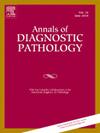Relationship between fibroblastic foci and respiratory function: Does the abundance of fibroblastic foci reflect a recent decline in respiratory function?
IF 1.5
4区 医学
Q3 PATHOLOGY
引用次数: 0
Abstract
Aims
Fibroblastic foci (FF) are main findings in idiopathic pulmonary fibrosis (IPF) but are not specific to IPF. Pirfenidone and nintedanib are standard antifibrotic treatments for IPF and affect factors associated with fibroblasts. A proportion of interstitial lung diseases (ILDs) are progressive fibrosing ILDs (PF-ILDs). This progressive fibrosing phenotype includes various ILDs, including fibrotic hypersensitivity pneumonitis (FHP) and connective tissue disease-related ILD (CTD-ILD). We examined the relationship between FF and a relative decline in respiratory function.
Methods and results
Among patients with lung transplantation (LT), those diagnosed with IPF, nonspecific interstitial pneumonia (NSIP), CTD-ILD, and FHP for whom respiratory function test results within 24 months before LT were retrospectively available were included (n = 67). Patients were classified as PF-ILD+ or PF-ILD- based on the criteria for the progression of a relative decline in the predicted value of forced vital capacity (FVC) within 24 months before LT. We classified FF into peripheral (pFF), alveolar (aFF), centrilobular (cFF), and distorted or dense fibrotic lesions (dFF). The number of FF/cm2 at each location was counted, and its percentage was calculated. Spearman's rank correlation coefficient between a relative decline in %FVC and total FF/cm2 in NSIP was 0.721. The dFF/cm2 and dFF/total FF ratios were higher and the aFF/total FF ratio was lower in the PF-ILD+ group than in the PF-ILD- group.
Conclusion
Total FF correlated with relative declines in %FVC in NSIP. Higher dFF/total FF ratios were associated with progressive status, and higher aFF/total FF ratios were associated with less progressive status.

纤维母细胞灶与呼吸功能的关系:纤维母细胞灶的丰富是否反映了近期呼吸功能的下降?
目的:成纤维细胞灶(fibroblastic focal, FF)是特发性肺纤维化(IPF)的主要表现,但并非特发性肺纤维化所特有。吡非尼酮和尼达尼布是IPF和成纤维细胞相关影响因素的标准抗纤维化治疗。一部分间质性肺疾病(ild)是进行性纤维化ild (pf - ild)。这种进行性纤维化表型包括各种ILD,包括纤维化超敏性肺炎(FHP)和结缔组织病相关ILD (CTD-ILD)。我们研究了FF与呼吸功能相对下降之间的关系。方法和结果在肺移植(LT)患者中,包括那些诊断为IPF、非特异性间质性肺炎(NSIP)、CTD-ILD和FHP的患者,他们在LT前24个月内的呼吸功能检查结果可回顾性获得(n = 67)。根据lt前24个月内强迫肺活量(FVC)预测值相对下降的进展标准,将患者分为PF-ILD+或PF-ILD。我们将FF分为外周性(pFF)、肺泡性(aFF)、小叶中心性(cFF)和扭曲或致密性纤维化病变(dFF)。统计每个位置的FF数/cm2,并计算其百分比。NSIP植被覆盖度百分比相对下降与总FF/cm2之间的Spearman等级相关系数为0.721。与PF-ILD-组相比,PF-ILD+组的dFF/cm2和dFF/总FF比值较高,aFF/总FF比值较低。结论总FF与NSIP患者FVC %的相对下降相关。较高的dFF/总FF比率与进展状态相关,较高的aFF/总FF比率与进展状态较差相关。
本文章由计算机程序翻译,如有差异,请以英文原文为准。
求助全文
约1分钟内获得全文
求助全文
来源期刊
CiteScore
3.90
自引率
5.00%
发文量
149
审稿时长
26 days
期刊介绍:
A peer-reviewed journal devoted to the publication of articles dealing with traditional morphologic studies using standard diagnostic techniques and stressing clinicopathological correlations and scientific observation of relevance to the daily practice of pathology. Special features include pathologic-radiologic correlations and pathologic-cytologic correlations.

 求助内容:
求助内容: 应助结果提醒方式:
应助结果提醒方式:


